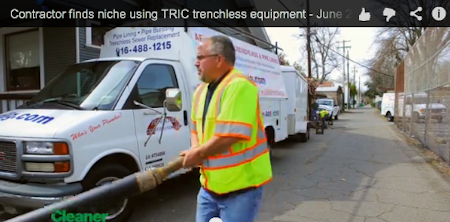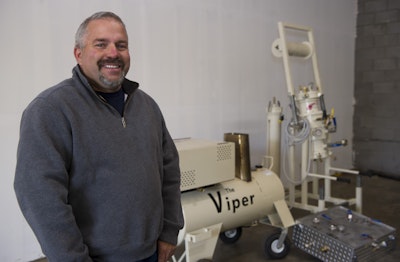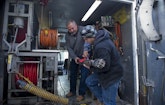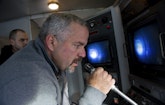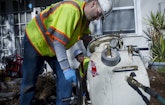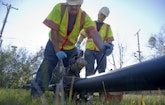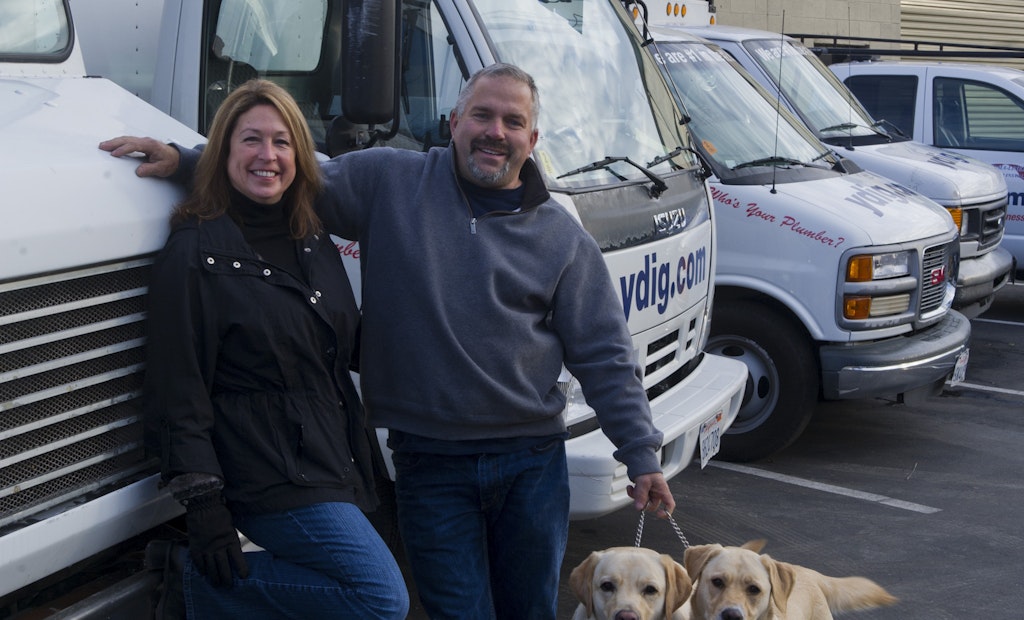
Interested in Municipal/Industrial?
Get Municipal/Industrial articles, news and videos right in your inbox! Sign up now.
Municipal/Industrial + Get AlertsRyan Petersen has seen his industry from several different perspectives over the course of 20 years. He knows what it’s like to work in a one- or two-man plumbing and drain cleaning operation. He has also headed up his own plumbing firm with six technicians and six service vans, but he found his comfort zone specializing in trenchless rehabilitation with two technicians, in addition to himself, and wife Karen running the office.
Petersen launched his own company, originally called Express Plumbing, in 2002 and quickly built it up to the complement of six technicians. After evaluating his priorities and considering the responsibilities involved with running a larger staff, he scaled back. Through that process, he established a model that has propelled the company, based in Sacramento, Calif., into one that is both innovative and highly successful.
A name change accompanied the shift in business strategy. The company is now known as Affordable Trenchless & Pipe Lining, which Petersen says better reflects its focus.
Expansion on the horizon
The strategy shift was spurred by Petersen’s discovery of pipe bursting, which had become an attractive and in-demand service, and the opportunities available for subcontractors. Affordable Trenchless now works throughout the Golden State, sometimes traveling as far as 400 miles to provide services for prime contractors.
What made this mission so challenging, and subsequently successful, is that Petersen first had to convince contractors he would never in any way attempt to take away clients. That was the tough part because people in the industry tended to be skeptical. Over the years, however, the company has earned the trust of its clients, providing a growing list of contractor customers.
“Pipe bursting was the first expanded service in 2004 because the technology was faster and we didn’t have to dig,” Petersen says. “Other companies in town were offering this and we wanted to keep up with what was going on. That was when we also scaled back to having just two technicians.”
The company purchased TRIC Tools equipment and the service quickly became a staple of their menu. Relining came along in 2006 when Petersen began working as a subcontractor repairing 2- to 6-inch sewer lines on a series of gas stations throughout the state.
“The contractor wanted us to come up with a method other than pipe bursting, and that is how we got involved with relining,” Petersen says. “We went to Perma-Liner Industries and bought their lateral lining system.”
Having this capability and equipment has provided opportunities with other contractors as well. In recent months, he has added more capabilities, and now offers manhole-to-manhole lining with Perma-Liner equipment. He also offers reinstating with a CUES-equipped van, filling yet another need for his customers.
The path to prestige
Petersen has been diligent in assuring contractors that his company will never cross over and take business from them, which he says is the hardest part of the business.
“If I have a subcontract involving a specific chain operation, say a specific coffee shop, I guarantee you will never see me in one of those unless it is for the contractor we initially worked for,” Petersen says. “And if a next-door neighbor of that coffee shop calls to ask if we can help them out, we will refer that call to our contractor client.”
Affordable Trenchless worked for a couple contractors early on and was then able to use them as references, which helped the contractor customer list grow.
“We had an agreement with the contractor we worked with doing gas stations that I would travel anywhere in California, if they would use me exclusively. Over the last seven years, we have performed for this contractor throughout the state.”
Petersen’s clients are all important, and while he notes that he and his two technicians have tackled some big jobs, there is no job too small to put on the schedule. A recent example was a job in Long Beach (some 400 miles south) where they needed to reinstate one hole in a 4-inch pipe. They were there with their IMS Robotics micro cutter, which has helped stake out another important piece of territory.
“Having this tool has contributed greatly to our success,” says Petersen. “We can not only line but reinstate the small-scale pipe. We just used this on a large hospital project in San Francisco.”
Petersen explains that in most instances, they bring the equipment and experience to a project, while the prime contractor provides extra manpower. But someone from Affordable Trenchless is always in control when it comes to operating the company’s sensitive equipment.
“I work with them on their projects with their guys,” Petersen says. “This way, I do not have to carry the manpower and that overhead. I am able to wholesale my pricing to the contractor because I don’t have the costs of a big staff and big shop with multiple trucks. The contractor does not have to have the pipe bursting or relining equipment, the television cameras.”
Straight arrow
In order to maintain his position as a subcontractor with the initial client, Petersen relies on the technician provided by the prime contractor to address any questions related to the job, such as pricing.
“There is no passing of business cards,” Petersen says. “We want the client to view our position as a subordinate only. We respond in a professional and courteous manner, but we defer to the representative from the prime contractor.”
Petersen and his team have had jobs last as long as four weeks, and the cost of their travel and all expenses are figured into the bid. They will spend a week working and head home for the weekend. They have worked from the Nevada state line to the San Francisco Bay Area (about 190 miles) and from Bakersfield to Redding (400-plus miles). The base price for the work is set by the footage and does not vary from one area to the next.
“Contractors are able to bid jobs off my per-footage price because it doesn’t matter if we are in Bakersfield, Redding or Sacramento,” Petersen says. “I’m still doing the same job, but just have to make up for the travel time and expenses involved.”
Petersen says they do a minimal amount of municipal work because he does not have the office staff required to take care of all the paperwork that is involved. “Commercial is more my cup of tea,” he says.
Because their work covers such an extensive area, conditions and regulations vary significantly. Pipes in need of repair are typically rotted cast iron, broken-up clay, and old collapsed Orangeburg. Roots are a common issue, and gas stations and convenience stores often have lines that have been damaged by the caustic nature of soft drinks.
With residential trenchless repair, each city tends to have its own set of rules. For example, in the City of Sacramento, the homeowner is responsible for their own lateral line to the fence line or sidewalk. In the San Francisco Bay Area, the customer will often be responsible to the middle of the street.
“It’s possible in some cities, because of requirements when working for a residential client, we might be pipe bursting to the sidewalk, and then relining to the middle of the street,” Petersen says.
A grade for equipment
Covering all of California for everything from small reinstatements to large pipe bursting jobs requires a capable fleet and a fully stocked toolbox. In addition to a variety of service vans and trucks, Affordable Trenchless relies on its CUES cutter truck, a 1998 GMC P3500 with two CUES truck-mounted NightOwl CP036 pan-and-tilt color cameras, two Ultra Shorty Crawlers (CUES), and a Bowman Dominator 430 cutter.
Other key pieces of equipment include the Perma-Lateral Inversion System (for 2- to 8-inch-diameter lines) with the Maverick II Hot Water Cure, the Perma-Main Continuous Lining Top Gun (for 4- to 14-inch lines) with the Viper Steam Cure, and Perma-Patch (mainly for 4- to 6-inch spot repair), all from Perma-Liner Industries, Inc.
Affordable Trenchless also relies on a Ring-O-Matic vacuum trailer, an Ingersoll Rand air compressor, a 2008 Hydro Jetter by General Pump (2,500 psi/18 gpm) and several RIDGID inspection cameras.
The assignment
“We take our jobs as they come,” notes Petersen. “One day we are televising a line to give an estimate in one town, and the next day we are redoing a shopping center in another. Our work schedule is probably about one week out except for larger jobs.
He says the company has been successful working with other contractors because it doesn’t matter if they’re working on the biggest job or the smallest, every customer is going to be treated the same.
The most rewarding aspect of running the company, Petersen says, is the reputation he has established and the fact that Affordable Trenchless has become one of the biggest subcontractors in the state. Still, wearing the many hats of owner, manager and technician presents challenges.
